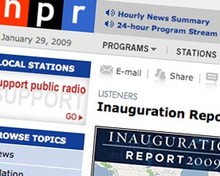
In the finale of what many described as the first 'digital election', user-generated content and social media really came into their own, as events were documented live.
The election campaign had already allowed experimentation with different online story-telling methods, so the National Public Radio (NPR) created its own Inauguration Report site to mark January 20.
Using a system of geographic tags, the site was able to collate and repurpose 40,000 multimedia submissions - including 30,000 on Twitter, thousands of Flickr images and hundreds of YouTube videos.
Andy Carvin, social media strategist at NPR, talked Journalism.co.uk through the site's coverage:
Why did you decide to cover inauguration day using such a social media approach?
[AC]Almost three years prior to the inauguration I wrote a blog post about how journalism would change when 'smart mobs' would be able to contribute editorial content in real time as a story breaks, like having eyewitnesses at a rally capturing police beatings of protestors.
I called it mobcasting - a play on smart mobs, mobile phones and podcasting. I was also involved in blogging projects related to the tsunami and Hurricane Katrina in which the public was encouraged to contribute first-hand accounts of what they were experiencing, so when I came to NPR in 2006, I was very eager to put those ideas to work in a professional journalistic context.
Throughout the 2008 presidential campaign we invited the public to send in dispatches to us about their voting experiences, and we started working with Dave Troy of Twittervision to come up with a way to map their tweets.
In October, Nancy Scola and Allison Fine at the blog TechPresident.com wrote a post about using Twitter specifically to document voting irregularities using the tag #votereport, so we combined forces to create the Vote Report project for the election. This project served as the basis for what we did on inauguration day.
What elements of the plans you made in December for Inauguration Report worked well?
It seems we hit most of the major goals. Our aggregator was able to collect Twitter posts, Flickr photos, YouTube videos, text messages, as well as multimedia submitted on iPhones and Google Android phones.
We ran out of time before we could set up the voicemail system, unfortunately, but that's the only platform we didn't deploy.
Twitter was far and away our biggest success because we managed to get a large part of the Twitter community using our #inaug09 tag in their posts. Other media entities like the Washington Post and Current.tv also started using the tag, which helped spread it even more.
Are there any other plans to make use of the contributions?
There's so much content we're now trying to figure out what to do with it all, beyond leaving it as a permanent archive for the public to search and explore.
We could have had more volunteers whose sole job was to peruse the content in assigned batches and help us find the best nuggets. That's something that worked pretty well on election day, but this time around, we had more content coming in and fewer volunteers reviewing it.
So while I view the project as a success, we’re also a victim of that success, because we're simply overflowing with user content. I think that will be one of the biggest takeaways for me: we need to have better structures in place for reviewing and curating the best content.
Geotagging for news hasn't really taken off yet in the UK, but the use of hashtags and location tags in this coverage seems to have been a key feature - why was this important?
We wanted to use geotagging to get a visual sense of the scale of participation. If you look at the US map we created, people all over the US were submitting content about what was happening in their communities regarding the inauguration.
We also wanted to see if it were possible to create a hyperlocal map of DC and pinpoint people across the city.
It worked well for iPhone users, since they have GPS in their phones, but it was harder for Twitter users and others, as they had to include street address or landmark information in their submissions.
Not as many people did that for this project as they did during Vote Report, so while the geodata was fascinating, it was harder to observe geographic trends like we did for Vote Report.
What will you remember about inauguration day 2009?
I will remember standing outside on the National Mall with around two million people, my fingertips frozen as I sent dozens of tweets from my Blackberry, and thinking I wasn't alone in my attempt at capturing the moment. It was the mobcast I'd been waiting for.
Free daily newsletter
If you like our news and feature articles, you can sign up to receive our free daily (Mon-Fri) email newsletter (mobile friendly).
Related articles
- Journalists are happy to be disconnecting from platforms, should news organisations be worried?
- Protecting journalists on social media, with Valérie Bélair-Gagnon
- What will your audience want in the future?
- 15 free sources of data on the media industry
- Predictions for journalism 2024: social media platforms and strategies









